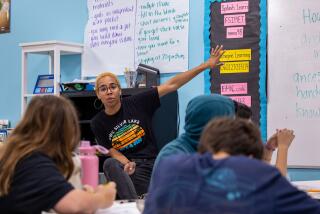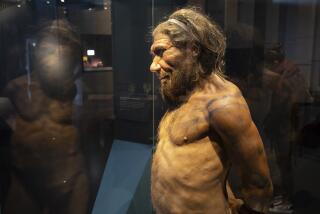Testing Darwinâs Teachers
LIBERTY, Mo. â Monday morning, Room 207: First day of a unit on the origins of life. Veteran biology teacher Al Frisby switches on the overhead projector and braces himself.
As his students rummage for their notebooks, Frisby introduces his central theme: Every creature on Earth has been shaped by random mutation and natural selection -- in a word, by evolution.
The challenges begin at once.
âIsnât it true that mutations only make an animal weaker?â sophomore Chris Willett demands. â âCause I was watching one time on CNN and they mutated monkeys to see if they could get one to become human and they couldnât.â
Frisby tries to explain that evolution takes millions of years, but Willett isnât listening. âI feel a tail growing!â he calls to his friends, drawing laughter.
Unruffled, Frisby puts up a transparency tracing the evolution of the whale, from its ancient origins as a hoofed land animal through two lumbering transitional species and finally into the sea. Heâs about to start on the fossil evidence when sophomore Jeff Paul interrupts: âHow are you 100% sure that those bones belong to those animals? It could just be some deformed raccoon.â
From the back of the room, sophomore Melissa Brooks chimes in: âThose are real bones that someone actually found? Youâre not just making this up?â
âNo, I am not just making it up,â Frisby says.
At least half the students in this class of 14 donât believe him, though, and theyâre not about to let him off easy.
Two decades of political and legal maneuvering on evolution has spilled over into public schools, and biology teachers are struggling to respond. Loyal to the accounts theyâve learned in church, students are taking it upon themselves to wedge creationism into the classroom, sometimes with snide comments but also with sophisticated questions -- and a fervent faith.
As sophomore Daniel Read put it: âIâm going to say as much about God as I can in school, even if the teachers canât.â
Such challenges have become so disruptive that some teachers dread the annual unit on evolution -- or skip it altogether.
In response, the American Assn. for the Advancement of Science is distributing a 24-page guide to teaching the scientific principles behind evolution, starting in kindergarten. The group also has issued talking points for teachers flustered by demands to present âboth sides.â
The annual science teachers convention next week in Anaheim will cover similar ground, with workshops such as âTeaching Evolution in a Climate of Controversy.â
âWeâre not going to roll over and take this,â said Alan I. Leshner, the executive publisher of the journal Science. âThese teachers are facing phenomenal pressure. They need help.â
About half of all Americans dismiss as preposterous the scientific consensus that life on Earth evolved from a common ancestor over millions of years. Some hold to a literal reading of Genesis: God created the universe about 6,000 years ago. Others accept an ancient cosmos but take the variety, complexity and beauty of Earthâs creatures as proof that life was crafted by an intelligent designer.
Religious accounts of lifeâs origins have generally been kept out of the science classroom, sometimes by court order. But polls show a majority of Americans are unhappy with the evolution-only approach.
Daniel Read, for instance, considers it his Christian duty to expose his classmates to the truths he finds in the Bible, starting with the six days of creation. Itâs his way, he said, of counterbalancing the textbook, which devotes three chapters to evolution but just one paragraph to creationism. A soft-spoken teen with shaggy hair and baggy pants, Daniel prepares carefully for his mission in this well-educated, affluent and conservative suburb of 28,000, just outside Kansas City, Mo. He studies DVDs distributed by Answers in Genesis, a âcreation evangelismâ ministry devoted to training children to question evolution.
Other students gather ammunition from sermons at church, or from the dozens of websites that criticize evolution as a God-denying sham. They interrupt lectures to expound on the inaccuracies of carbon dating; to disparage transitional fossils as frauds; to show photos of ancient footprints that they think prove humans and dinosaurs walked side by side.
Most will learn what they need to pass the test, but some make their skepticism clear by putting their heads down on their desks or even stalking out of class.
Liberty High School senior Sarah Hopkins was proud of her response when a botany teacher brought up evolution last year: âI asked, âHave you ever read the Bible? Have you ever gone to church?â â
Such personal questions can make teachers uncomfortable, but theyâre fairly easy to deflect. Far tougher are the science-based queries that force teachers to defend a theory they may not ever have studied in depth.
âIf a teacher is making a claim that land animals evolved into whales, students should ask: âWhat precisely is involved? How does the fur turn into blubber, how do the nostrils move, how does the tiny tail turn into a great big fluke?â â said John Morris, president of the Institute for Creation Research near San Diego. âEvolution is so unsupportable, if you insist on more information, the teacher will quickly run out of credibility,â he said.
Anxious to forestall such challenges, nearly one in five teachers makes a point of avoiding the word âevolutionâ in class -- even when theyâre presenting the topic, according to a survey by the National Science Teachers Assn.
âTheyâre saying they donât know how to respond.... They havenât done the research the kids have done on this,â said Linda Froschauer, the groupâs president-elect.
In a classroom cluttered with paper models of DNA, newspaper clippings about global warming and oddities such as a four-eared pig in formaldehyde, Frisby parries his studentsâ questions patiently but with a bit of disappointment.
For the first 27 years of his career, he taught lifeâs origins without controversy. Then in 1999, the Kansas Board of Education deleted evolution from the mandatory science curriculum.
Frisby was teaching biology at the time in Shawnee Mission, Kan., and he was determined not to alter his curriculum. His students, however, seemed emboldened by the boardâs action.
The daughter of a local minister took to bringing in creationist research that she thought proved Charles Darwin wrong. That year, more than a third of the students wrote in their class evaluations that they did not accept their teacherâs account of how life emerged.
Kansas restored evolution to the science curriculum in 2001 after conservatives lost their majority on the board. A subsequent election again shifted the balance, and last year the board issued a mandate that still stands: Students must be taught that the theory of evolution is a âhistorical narrativeâ based on circumstantial evidence. They must also learn specific criticisms of evolution.
Though he retired from his Kansas teaching job in 2002 for personal reasons, Frisby remains active in efforts there to elect a more liberal state school board. His job across the state line in Missouri is less political; Missouri does not require teachers to introduce criticisms of evolution or alternative accounts of lifeâs origins. Nonetheless, those views come up in Room 207 every year.
Toward the end of his second class one recent morning, Frisby held up an old issue of National Geographic. The cover asked in bold type: âWas Darwin Wrong?â
âYes!â one student called.
Another backed him up: âYes!â
Six or eight other voices joined in. Frisby quieted them and opened to the article inside, which began with the one-word answer: âNo.â
âItâs my job to show you the overwhelming evidence for evolution,â he said.
âWhat about the other side?â Jeff Paul called. An approving murmur swept the room.
Frisby, 59, rarely gets angry at such interruptions; even his most skeptical students praise his willingness to listen. He has attended two creationist conferences to hear their evidence firsthand; he digs out articles that respond to their doubts; heâll even sit down with a student to talk about God -- though only after class.
Growing up in nearby Independence, Mo., Frisby learned the biblical creation account from his mother, a Sunday school teacher. âI believed it without question,â he said. âIt was literal to me.â
He doesnât remember hearing about evolution in high school, but then he didnât pay much attention to academics. It wasnât until college that he discovered a passion for biology.
One evening in 1968, Frisby was dissecting a sharkâs heart for a night course. As he spread the organ out in front of him, studying the looping valves and arteries, he had what he can only describe, with wonder, as a religious experience. âAll those beautiful arches coming off the heart -- it was just too perfect,â he said. âI thought to myself, âGod could have created this animal just this way.â â
That satisfied his religious nature. But the scientist within him wouldnât let the matter rest. Dissecting more animal hearts, Frisby found the same awe-inspiring beauty. He also came to understand how an organ as complex as the heart could evolve; he could see the progression there on his lab table, from one chamber to two to four.
Frisby still believed that God created the universe, but his faith couldnât tell him what happened next; to answer that question, he concluded, he would need science.
At 22, he decided the best way to honor his faith was to hold it sacred in his heart -- and to keep it out of his lab.
Casting about for ways to explain that to his students, Frisby tried a new approach this year: He strapped a leather tool belt around his waist. Life, he told the class, required a variety of tools. Sometimes they would find it helpful to use art or music to help them make sense of their world. Sometimes they would use religion.
âWeâre in science class now, so weâre going to use our science tools,â he told them. âI donât want to be in a debate about religion or literature or art. My job is to explain evolution so you can understand it. Whether you accept it or not, thatâs your business.â
On the wall behind him, a poster read: âCourage is what it takes to stand up and speak. Courage is also what it takes to sit down and listen.â
To engage students who might be inclined to tune out, Frisby fills his lesson plans with hands-on activities.
In one, heâll unspool a long roll of adding-machine tape and have the kids make a timeline of Earthâs history. Theyâll be able to see at a glance how long it took for a vast diversity of creatures to evolve, from the humble worm 430 million years ago to the first fish 345 million years ago and on through dinosaurs and mammals. On his timeline, early man wonât appear until the very end of the paper.
Frisby hopes the exercise will make an impression on students like Chris Willett, who offered this rebuttal to evolution: âI think itâs kind of strange that they can find all these dinosaur fossils from what you say is millions of years ago, but they canât find any transitional human fossils.â
Frisby promised to show the class several fossils that document the halting and gradual evolution from apes to humans. Then he reminded them not to expect equal numbers of human and dinosaur remains, because hominids emerged only recently, while dinosaurs ruled the planet for nearly 200 million years.
At that, sophomore Derik Montgomery snapped to attention. âI heard that dinosaurs are only thousands of years old, like 6,000. Not millions,â he said.
âThatâs wrong,â Frisby responded briskly. âWhat can I tell you? You canât believe everything you read.â
Sprawled out across his chair, Derik muttered: âYou canât believe everything you hear in here, either.â
Frisby put up his next transparency.
More to Read
Sign up for Essential California
The most important California stories and recommendations in your inbox every morning.
You may occasionally receive promotional content from the Los Angeles Times.










